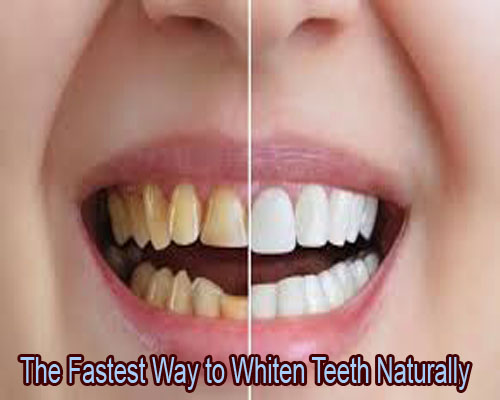The Fastest Way to Whiten Teeth Naturally
Discover the fastest and safest ways to whiten teeth naturally using proven home remedies, backed by science, for a brighter, healthier smile.

The Pursuit of a Whiter Smile
In a world where your smile is often the first thing people notice, having white teeth has become more than just a cosmetic desire—it’s a sign of health, youth, and confidence. But with the overwhelming amount of whitening products on the market today, many people are asking: Is there a safe, effective, and natural way to whiten teeth naturally and quickly?
The good news? Yes, there is.
In this article, we will explore science-backed methods to naturally whiten your teeth, avoid common pitfalls, and uncover what really works—without the sensitivity, damage, or cost that often comes with chemical treatments.
Understanding Why Teeth Get Discolored
Before diving into whitening methods, it’s essential to understand what causes teeth to lose their luster in the first place. Common causes include:
- Dietary habits: Coffee, tea, red wine, and dark-colored berries are major culprits.
- Smoking: Nicotine and tar deeply stain the enamel.
- Poor oral hygiene: Plaque and tartar buildup contribute to discoloration.
- Aging: As we age, enamel wears down, revealing the naturally yellow dentin beneath.
- Certain medications: Some antibiotics and antihistamines can stain teeth over time.
Knowing the source of discoloration helps tailor the right approach to whitening naturally.
1. Oil Pulling (Ancient, Gentle, Effective)
Oil pulling is an ancient Ayurvedic practice that involves swishing oil (typically coconut oil) in your mouth for 10–20 minutes.
Why it works:
- Removes harmful bacteria that cause plaque
- Helps reduce inflammation and improves gum health
- May gradually lift surface stains with consistent use
How to use:
- Use 1 tablespoon of organic coconut oil.
- Swish gently for 10–20 minutes (don’t swallow).
- Spit into the trash (not the sink), rinse with warm water, and brush as usual.
Consistency is key—most people notice improvements within 1-2 weeks.
2. Baking Soda and Hydrogen Peroxide Paste
Baking soda is mildly abrasive and helps scrub away surface stains, while hydrogen peroxide acts as a natural bleaching agent.
How to make it:
- Mix 1 tsp of baking soda with 1–2 tsp of 3% hydrogen peroxide to form a paste.
- Brush gently for 1–2 minutes, 2–3 times a week.
Important:
- Do not overuse. Excessive use can erode enamel.
- Use a soft-bristled brush and apply minimal pressure.
3. Eat Natural Whitening Foods
Some fruits and vegetables naturally cleanse and polish your teeth as you chew:
- Strawberries: Contain malic acid, a natural enamel whitener
- Pineapple: Contains bromelain, which helps break down plaque
- Crunchy vegetables: Like apples, carrots, and celery act like natural toothbrushes
Add these to your daily diet for continuous, gentle whitening support.
4. Brush with Activated Charcoal (Sparingly)
Activated charcoal is highly absorbent and may help bind stains and toxins from your teeth.
How to use:
- Wet your toothbrush and dip it in food-grade activated charcoal.
- Brush gently for 2 minutes, then rinse thoroughly.
Note: Use only once or twice a week, and avoid if you have crowns or veneers.
5. Limit Staining Foods and Beverages
Preventing future stains is just as important as whitening:
- Use a straw for coffee, tea, or soda to minimize contact
- Rinse your mouth or brush your teeth after consuming stain-causing foods
- Chew sugar-free gum to stimulate saliva production and wash away acids
6. Maintain Optimal Oral Hygiene
Natural whitening won’t work without a solid foundation of oral hygiene:
- Brush twice daily with a fluoride-free, gentle whitening toothpaste
- Floss once daily to remove plaque between teeth
- Rinse with natural mouthwashes like salt water or aloe vera
7. Try Natural Whitening Toothpaste Alternatives
Natural whitening pastes made with ingredients like bentonite clay, xylitol, and peppermint oil can gradually remove stains while supporting healthy enamel.
Some of the best options include:
- DIY recipes with coconut oil and baking soda
- Store-bought organic pastes with natural enzymes
A Word About Over-the-Counter Products
While many commercial whitening strips and bleaches offer fast results, they often contain peroxide concentrations that can:
- Cause tooth sensitivity
- Damage enamel over time
- Irritate gums
That’s why more people are seeking natural alternatives that offer lasting, gentle results without the risk.
Bonus Tip: Nourish Your Oral Microbiome
Your mouth is full of bacteria—and not all of them are bad. In fact, a healthy oral microbiome is key to keeping your teeth white and gums healthy.
Recent science has shown that maintaining this balance can:
- Reduce plaque
- Prevent decay
- Naturally brighten teeth over time
Supporting your microbiome through diet, probiotics, and certain supplements may give your whitening routine an unexpected boost.
Looking for a Holistic Oral Health Solution?
If you’re interested in improving not only the color of your teeth but also the health of your entire mouth, there are advanced solutions designed to support your oral microbiome and enamel strength in a completely natural way.
We’ve recently explored a breakthrough supplement packed with beneficial bacteria and enamel-supporting nutrients. It’s gaining significant attention for its holistic approach to oral care.
You can read our in-depth review and learn more about it here:
👉 Check out our complete ProDentim Review
Conclusion: Nature Knows Best
Whitening your teeth naturally doesn’t have to be slow or complicated. With the right habits, science-backed methods, and consistency, you can enjoy a brighter, healthier smile without sacrificing your enamel or your peace of mind.
Remember, your smile is your first impression. Make it count, the natural way.